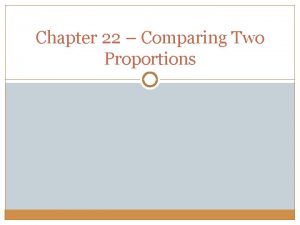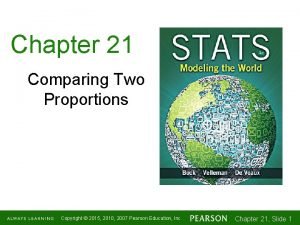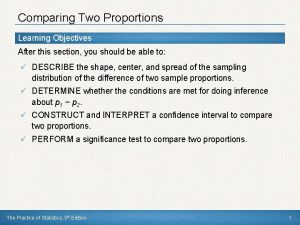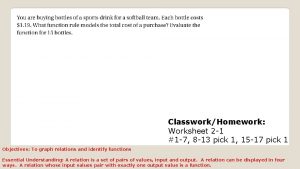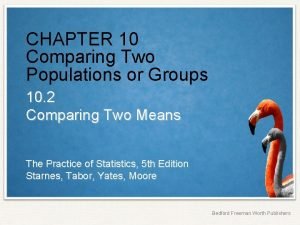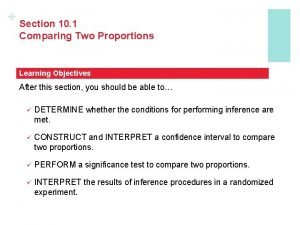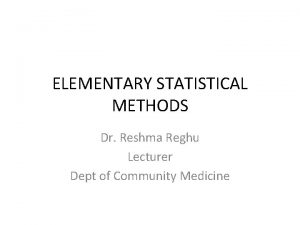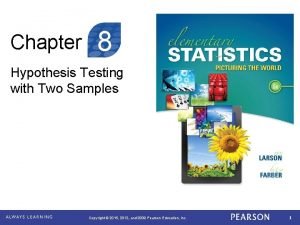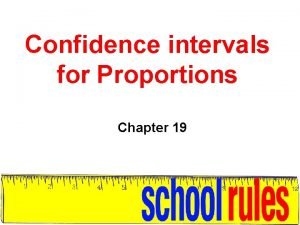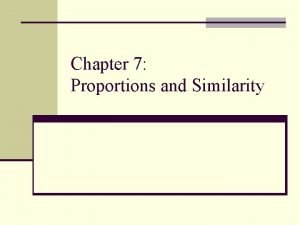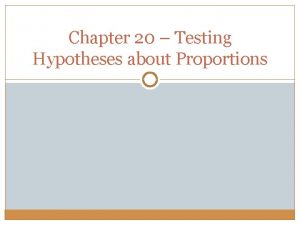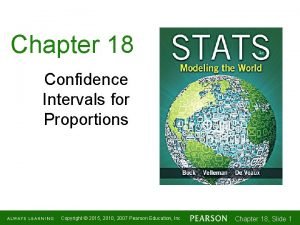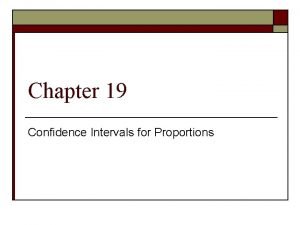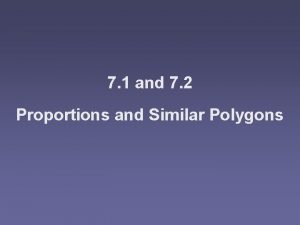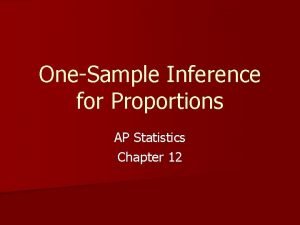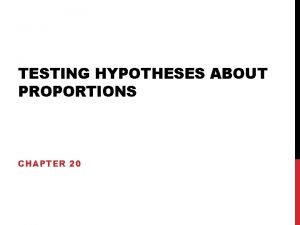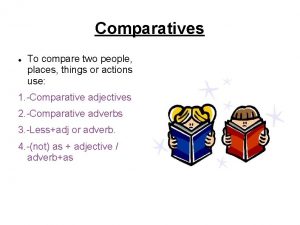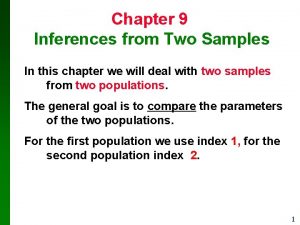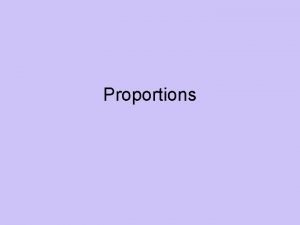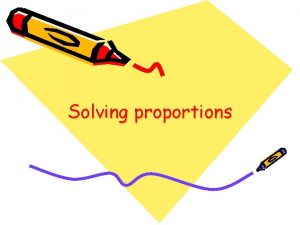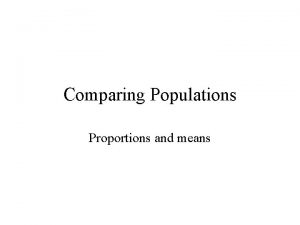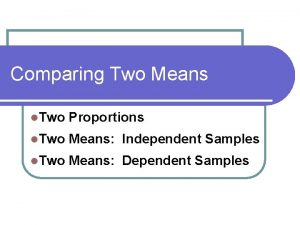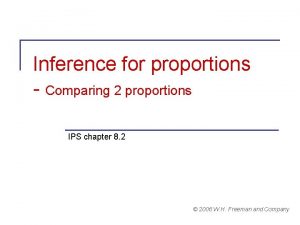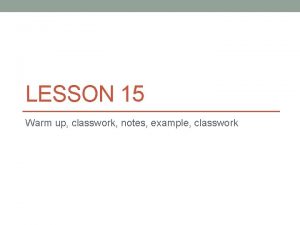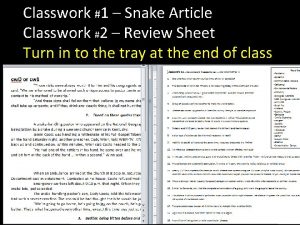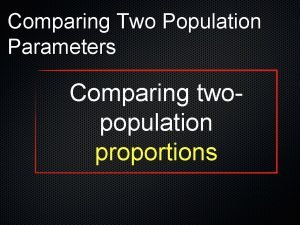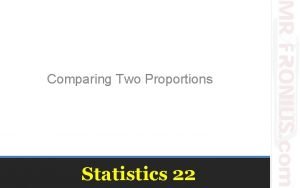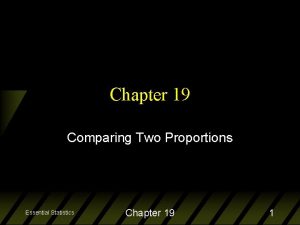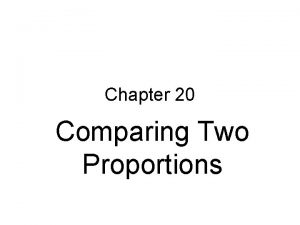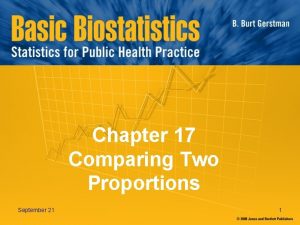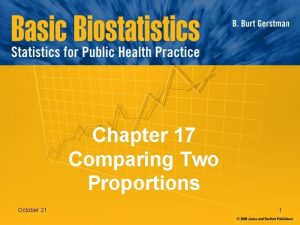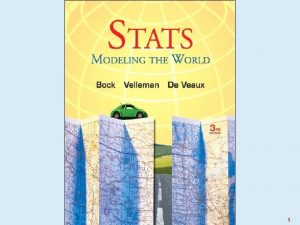Chapter 21 Comparing Two Proportions Classwork n Comparing



























- Slides: 27

Chapter 21 Comparing Two Proportions

Classwork n Comparing Two Proportions: Female and Male Drivers

Assumptions and Conditions n Independence Assumptions: n n n Randomization Condition: The data in each group should be drawn independently and at random. The 10% Condition: The sample should not exceed 10% of the population. Independent Groups Assumption: The two groups we’re comparing must be independent of each other.

Assumptions and Conditions (cont. ) n Sample Size Condition: n n Each of the groups must be big enough… Success/Failure Condition: Both groups are big enough that at least 10 successes and at least 10 failures have been observed in each.

Classwork: n Checking Assumptions and Conditions

The Sampling Distribution n n We know that for large enough samples, each of our proportions has an approximately Normal sampling distribution. The same is true of their difference.

The Sampling Distribution (cont. ) n The sampling distribution of Normal model with n Mean: n Standard deviation: is modeled by a

Two-Proportion z-Interval n n When the conditions are met, we are ready to find the confidence interval for the difference of two proportions: The confidence interval is where n The critical value z* depends on the particular confidence level, C, that you specify.

Classwork: n n Finding a Two-Proportion z-Interval Graphing Calculator: Finding the Confidence Interval

Homework: n n n Read Chapter 21 Guided Reading Pg 557 -558 Ex: 2, 4, 5, 7, 10, 13

“Do Now” n Interpreting a Two Proportion z-Interval

Classwork: n Will I Snore When I’m 64?

Everyone into the Pool: n n The typical hypothesis test for the difference in two proportions is the one of no difference. In symbols, H 0: p 1 – p 2 = 0. Since we are hypothesizing that there is no difference between the two proportions, the standard deviations for each proportion are the same. Since this is the case, we combine (pool) the counts to get one overall proportion.

Everyone into the Pool (cont. ) n The pooled proportion is where n and If the numbers of successes are not whole numbers, round them first. (This is the only time you should round values in the middle of a calculation. )

Everyone into the Pool (cont. ) n We then put this pooled value into the standard error formula, substituting it for both sample proportions:

Compared to What? n n n We’ll reject our null hypothesis if we see a large enough difference in the two proportions. How can we decide whether the difference we see is large? n Just compare it with its standard deviation. Unlike previous hypothesis testing situations, the null hypothesis doesn’t provide a standard deviation, so we’ll use a standard error (here, pooled).

Two-Proportion z-Test n n n The conditions for the two-proportion z-test are the same as for the two-proportion z-interval. We are testing the hypothesis H 0: p 1 – p 2 = 0, or, equivalently, H 0: p 1 = p 2. Because we hypothesize that the proportions are equal, we pool them to find

Two-Proportion z-Test (cont. ) n n n We use the pooled value to estimate the standard error: Now we find the test statistic: When the conditions are met and the null hypothesis is true, this statistic follows the standard Normal model, so we can use that model to obtain a P-value.

Classwork: n Step-by-Step Example: A Two-Proportion z-Test

Homework: Read Chapter 21 n Guided Reading n Pg 558 – 559; Ex: 19, 21, 24, 26 (Completely answer each part of the problems) n

Classwork: n “Do Now”: Comparing Two Proportions

Classwork: n Graphing Calculator: Testing the Hypothesis

Classwork: n Example: Another Two-Proportion Z-Test

Homework: n n Read Chapter 21 Guided Reading Chapter 21 Homework: Comparing Two-Proportions Chapter 21 Quiz on____________

What Can Go Wrong? n n n Don’t use two-sample proportion methods when the samples aren’t independent. n These methods give wrong answers when the independence assumption is violated. Don’t apply inference methods when there was no randomization. n Our data must come from representative random samples or from a properly randomized experiment. Don’t interpret a significant difference in proportions causally. n Be careful not to jump to conclusions about causality.

What have we learned? n n We’ve now looked at inference for the difference in two proportions. Perhaps the most important thing to remember is that the concepts and interpretations are essentially the same—only the mechanics have changed slightly.

What have we learned? (cont. ) n Hypothesis tests and confidence intervals for the difference in two proportions are based on Normal models. n Both require us to find the standard error of the difference in two proportions. n We do that by adding the variances of the two sample proportions, assuming our two groups are independent. n When we test a hypothesis that the two proportions are equal, we pool the sample data; for confidence intervals we don’t pool.
 Chapter 22 comparing two proportions
Chapter 22 comparing two proportions Standard error of difference between two proportions
Standard error of difference between two proportions Chapter 22 comparing two proportions
Chapter 22 comparing two proportions Chapter 22 comparing two proportions
Chapter 22 comparing two proportions Chapter 22 comparing two proportions
Chapter 22 comparing two proportions Science classwork
Science classwork Classwork/homework linear functions answer key
Classwork/homework linear functions answer key Goole classroo m
Goole classroo m A boundless 3 dimensional set of all points
A boundless 3 dimensional set of all points Is classwork one word
Is classwork one word Chapter 10 comparing two populations or groups crossword
Chapter 10 comparing two populations or groups crossword Chapter 10 comparing two populations or groups
Chapter 10 comparing two populations or groups Z-test for proportions
Z-test for proportions Define standard error in statistics
Define standard error in statistics Standard error of difference between two proportions
Standard error of difference between two proportions Chapter 19 confidence intervals for proportions
Chapter 19 confidence intervals for proportions Chapter 7 similarity
Chapter 7 similarity Chapter 20 testing hypotheses about proportions
Chapter 20 testing hypotheses about proportions Chapter 18 confidence intervals for proportions
Chapter 18 confidence intervals for proportions Chapter 19 testing hypotheses about proportions
Chapter 19 testing hypotheses about proportions Chapter 19: confidence intervals for proportions
Chapter 19: confidence intervals for proportions Geometry chapter 7 proportions and similarity answers
Geometry chapter 7 proportions and similarity answers Chapter 12 inference for proportions answers
Chapter 12 inference for proportions answers Chapter 20 testing hypotheses about proportions
Chapter 20 testing hypotheses about proportions Comparing two things literary device
Comparing two things literary device Comparison of two dissimilar things
Comparison of two dissimilar things Compare and contrast two places
Compare and contrast two places Comparing two population variances
Comparing two population variances
